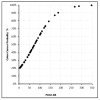The Diagnostic Significance of PDGF, EphA7, CCR5, and CCL5 Levels in Colorectal Cancer
- PMID: 31505877
- PMCID: PMC6770732
- DOI: 10.3390/biom9090464
The Diagnostic Significance of PDGF, EphA7, CCR5, and CCL5 Levels in Colorectal Cancer
Abstract
In this study, we compared the levels of C-C chemokine receptor type 5 (CCR5), C-C motif chemokine ligand 5 (CCL5), platelet-derived growth factor (PDGF), and EphrinA7 (EphA7) in patients with colorectal carcinoma and healthy controls in order to investigate the significance and usability of these potential biomarkers in early diagnosis of colorectal cancer. The study included 70 colorectal carcinoma patients and 40 healthy individuals. The CCR5, CCL5, PDGF, and EphA7 levels were measured using ELISA in blood samples. PDGF-BB, EphA7, CCR5, and CCL5 levels of the patients with colorectal carcinoma were significantly higher compared to the control group (p < 0.001 for each comparison). Our logistic regression analysis (the area under the curve was 0.958) supports the notion that PDGF-BB, EphA7, and CCL5 are potential biomarkers for the diagnosis of colon cancer. The sensitivity, specificity, and positive and negative predictive values were found to be 87.9%, 87.5%, 92.1%, and 81.4%, respectively. To our knowledge, this is the first study that investigates the relationship between colorectal carcinoma and the four biomarkers CCL5, CCR5, PDGF, and EphA7. The significantly elevated levels of all these parameters in the patient group compared to the healthy controls indicate that they can be used for the early diagnosis of colorectal carcinoma.
Keywords: CCL5; CCR5; EphA7; PDGF; chemokine; colorectal carcinoma; cytokine.
Conflict of interest statement
The authors declare no conflict of interest. The funders had no role in the design of the study; in the collection, analyses, or interpretation of data; in the writing of the manuscript, or in the decision to publish the results.
Figures
Similar articles
-
The Role of Biomarkers in the Early Diagnosis of Gastric Cancer: A Study on CCR5, CCL5, PDGF, and EphA7.Curr Issues Mol Biol. 2024 Sep 23;46(9):10651-10661. doi: 10.3390/cimb46090632. Curr Issues Mol Biol. 2024. PMID: 39329983 Free PMC article.
-
C-C motif chemokine ligand 5 and C-C chemokine receptor type 5: possible diagnostic application in breast cancer patients.Acta Biochim Pol. 2020 Nov 27;67(4):539-449. doi: 10.18388/abp.2020_5402. Acta Biochim Pol. 2020. PMID: 33245226
-
Genetic variants in CCL5 and CCR5 genes and serum VEGF-A levels predict efficacy of bevacizumab in metastatic colorectal cancer patients.Int J Cancer. 2019 May 15;144(10):2567-2577. doi: 10.1002/ijc.31968. Epub 2018 Dec 14. Int J Cancer. 2019. PMID: 30411783 Free PMC article.
-
Inhibition of the CCL5/CCR5 Axis against the Progression of Gastric Cancer.Int J Mol Sci. 2018 May 16;19(5):1477. doi: 10.3390/ijms19051477. Int J Mol Sci. 2018. PMID: 29772686 Free PMC article. Review.
-
The potential to target CCL5/CCR5 in breast cancer.Expert Opin Ther Targets. 2014 Nov;18(11):1265-75. doi: 10.1517/14728222.2014.949238. Epub 2014 Sep 26. Expert Opin Ther Targets. 2014. PMID: 25256399 Review.
Cited by
-
Role of Extracellular Matrix in Gastrointestinal Cancer-Associated Angiogenesis.Int J Mol Sci. 2020 May 23;21(10):3686. doi: 10.3390/ijms21103686. Int J Mol Sci. 2020. PMID: 32456248 Free PMC article. Review.
-
The effect of CCL5 on the immune cells infiltration and the prognosis of patients with kidney renal clear cell carcinoma.Int J Med Sci. 2020 Oct 18;17(18):2917-2925. doi: 10.7150/ijms.51126. eCollection 2020. Int J Med Sci. 2020. PMID: 33173412 Free PMC article.
-
The "Janus Face" of Platelets in Cancer.Int J Mol Sci. 2020 Jan 25;21(3):788. doi: 10.3390/ijms21030788. Int J Mol Sci. 2020. PMID: 31991775 Free PMC article. Review.
-
Potential role of the Eph/ephrin system in colorectal cancer: emerging druggable molecular targets.Front Oncol. 2024 Apr 2;14:1275330. doi: 10.3389/fonc.2024.1275330. eCollection 2024. Front Oncol. 2024. PMID: 38651144 Free PMC article. Review.
-
EphA7 isoforms differentially regulate cortical dendrite development.PLoS One. 2020 Dec 4;15(12):e0231561. doi: 10.1371/journal.pone.0231561. eCollection 2020. PLoS One. 2020. PMID: 33275600 Free PMC article.
References
-
- Aydin I., Sehitoglu I., Özer E., Yücel A., Pergel A., Bedir R. The evaluation of patients operated due to colorectal cancer. Kocaeli Med. J. 2015;16:102–109.
MeSH terms
Substances
LinkOut - more resources
Full Text Sources
Medical
Miscellaneous






